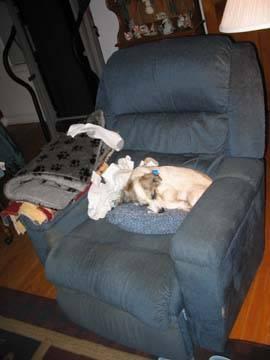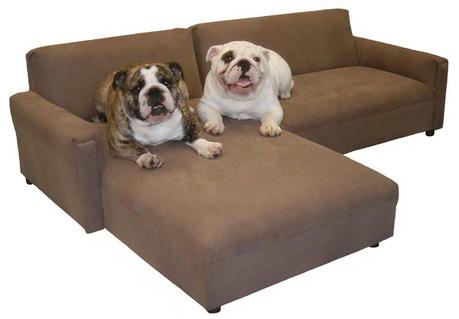 Dogs enjoy furniture for the same reasons we do. Some humans enjoy lounging around on the floor, but furniture in homes is certainly common and much used. Also like humans, many dogs have joint problems that make lying on the floor painful.
Dogs enjoy furniture for the same reasons we do. Some humans enjoy lounging around on the floor, but furniture in homes is certainly common and much used. Also like humans, many dogs have joint problems that make lying on the floor painful.
If you’re not going to allow your dog on the furniture, provide a bed with the right padding and warmth for his needs. It doesn’t have to be expensive. You can buy egg-crate foam intended for human mattress pads, cut it to the right size, and wrap it with an old sheet for a cool-seeking dog, or use an old blanket for a warmth-seeking dog. For some dogs, you’ll need warmth for part of the year and coolness for part of the year.
The Right Start
Once a dog forms the habit of getting up on furniture, change is difficult. If you want to keep your dogs off the furniture, your best bet is to start EVERY puppy and new dog in your home with “off the furniture” as a CONSISTENT rule. This means that everyone in the family has to cooperate in keeping the dog off the furniture. Just one uncooperative person can ruin the training and create a situation that is unfair to the dog.
Do not leave a puppy or dog alone around furniture until training is complete. Someone must supervise, just as you will be doing anyway for housetraining, and teach the dog to chew only dog toys, and not inappropriate items.
Be gentle when removing the dog from furniture. It’s best not to touch the dog at all, other than to lift a puppy or small dog and place him gently on the floor. Puppies and small dogs can be injured by jumping off of furniture.
For larger dogs who won’t be harmed by getting down on their own, it is safer and more effective to lure and/or cue the dog to get off the furniture, and reward the dog for being back on the floor. People often arouse aggression in dogs by angrily ejecting them from furniture, which can both trigger defense drives in dogs and cause pain if the dog has an orthopedic problem. Orthopedic problems, both inherited and injury related, are so common in dogs that this is a frequent cause for a dog to react aggressively when forced to get up from a comfortable position and jump down to the floor.

If the dog is an adult and new to your home, consider keeping a leash on him when teaching the dog to get off furniture in order to have good control. A head halter is an additional safeguard if the dog shows any tendency to react defensively.
Don’t drag the dog off furniture with the leash. Induce the dog to return to the floor while you simply hold the leash, keeping it slack, with no tension pulling against the dog. The leash is merely a safety, “just in case.” If the dog is off-leash, avoid grabbing the collar or otherwise physically forcing the dog. Either of those maneuvers can be dangerous.
Keep temper out of it. You’re teaching the dog what you DO want, not scolding or punishing him for the behavior you do not want. This approach will lead to everyone in the family eventually being able to remind the dog about furniture when necessary without risking a defensive reaction from the dog.
Remember that you need a place for the dog to comfortably rest. You’re teaching the dog WHERE to rest, not just where NOT to rest. So, have a comfy bed in place. The place for it is near the family, which means that you might need several comfy resting places for the dog so that obeying you does not place the dog in social isolation. Social isolation is punishment for a dog, and you want the right behavior to be rewarding.
Reward the dog in the chosen resting place. Do this both when you have just cued the dog to go to the place, and also when you notice the dog has gone to that place without a cue. Use tiny treats, special chew toys, praise, petting, toys with food inside them, and other rewards your dog can enjoy while resting on the bed.
If you do this training right from the start, a puppy will never develop the habit of getting up on furniture. A dog that is new to your home is also more “teachable” about things like this right from the start, because so much is new to the dog that there’s a special openness to learning new ways and new rules.
Oops, A Habit
When a dog has already formed the habit of getting up on furniture, changing that behavior is more challenging than getting the desired habit from the start. The dog will probably always have some tendency to get up on furniture when no one is around. You will need to keep the dog from having access to the furniture when you’re not supervising for quite some time, and possibly even for life.
Rooms with furniture that the dog likes to get on, such as bedrooms, the living room, and possibly family rooms can be gated off so that the dog can’t go in there without a human to supervise. Alternatively, the dog could be crated, but if getting on furniture is the only reason, gating off the areas gives the dog more room to move joints and exercise muscles, and can be healthier than crating.
Some people find that a Scat Mat (you can buy it through pet catalogs) will keep a dog off the sofa. It gives the dog a shock when he gets up. Obviously, you can’t have the Scat Mat on the sofa if you’re using it. Electric shock also carries the risk of “superstitious behavior,” with a dog developing fear or aggression toward something experienced at the same time as the shock.

Some dogs like to get up high to see things. If this is the case, it can help to either block the dog’s view from the furniture, or provide a better view elsewhere. Maybe move the furniture.
Compromise
A popular solution to this problem is to use slipcovers on the furniture. They could be formal ones, beautifully made, or just bed sheets, comforters, blankets, and so on, tossed over the sofa to keep it from picking up dog hair and dirt. Then, people can go ahead and allow the dog on the furniture. It’s even possible to teach a dog to wait for the sheet to be put on the furniture before getting up on it.
Another solution some people use is to get a piece of furniture for the dog–the only one the dog is allowed to use. You can keep an old sofa for this purpose. This furniture has to be in the area of the house where the dog WANTS to be, not somewhere isolated from where the rest of the family hangs out.
Why?
In an all-adult household where every family member happily welcomes the easy-tempered dog on furniture, it might seem unnecessary to keep the dog off the furniture. But before making this choice, take careful thought.
Puppies should not be allowed on furniture until their adult temperaments become evident, either during or after puberty. At that point, it will become clear that some of pups should NEVER be allowed on furniture, due to unsuitable temperament.
Puppies and small dogs can be injured jumping off furniture. If you do decide to allow your small dog on furniture, you’ll need to either teach the dog to wait to be lifted down, or provide a ramp and train the dog to use it consistently.
Houses with children are well advised to keep dogs off furniture. Young kids running up to beds startle dogs out of sleep and have their faces in exactly the right place for a bite to cause lifelong disfigurement. If you don’t have young children, what about grandchildren or other relatives, children of friends, and so on? If not now, what about five or ten years from now when you still have the dog and his habits are set?
If there is anyone in the household who is fussy about dog hair on clothing, or you expect to entertain guests you wouldn’t want to offend by covering their clothes with dog hair, these are reasons to teach the dog to stay off furniture. Remember that changing the rules later is very hard on a dog. It’s more humane to train a dog the way you want things to be later, right from the start.

“Off the furniture” is a good habit for people to teach their dogs, especially puppies. You can easily change later if the dog’s temperament and the circumstances in the home make it reasonable for the dog to share the family’s furniture. It’s unusual to find a dog who won’t learn to get up on furniture when the family wants this change, even after years of never doing so.
~Courtesy of Kathy Diamond Davis, the author of the book Therapy Dogs: Training Your Dog to Reach Others
Comments
Tags: bad habbit, couch, Dog, fur, furniture, Tips, Training
